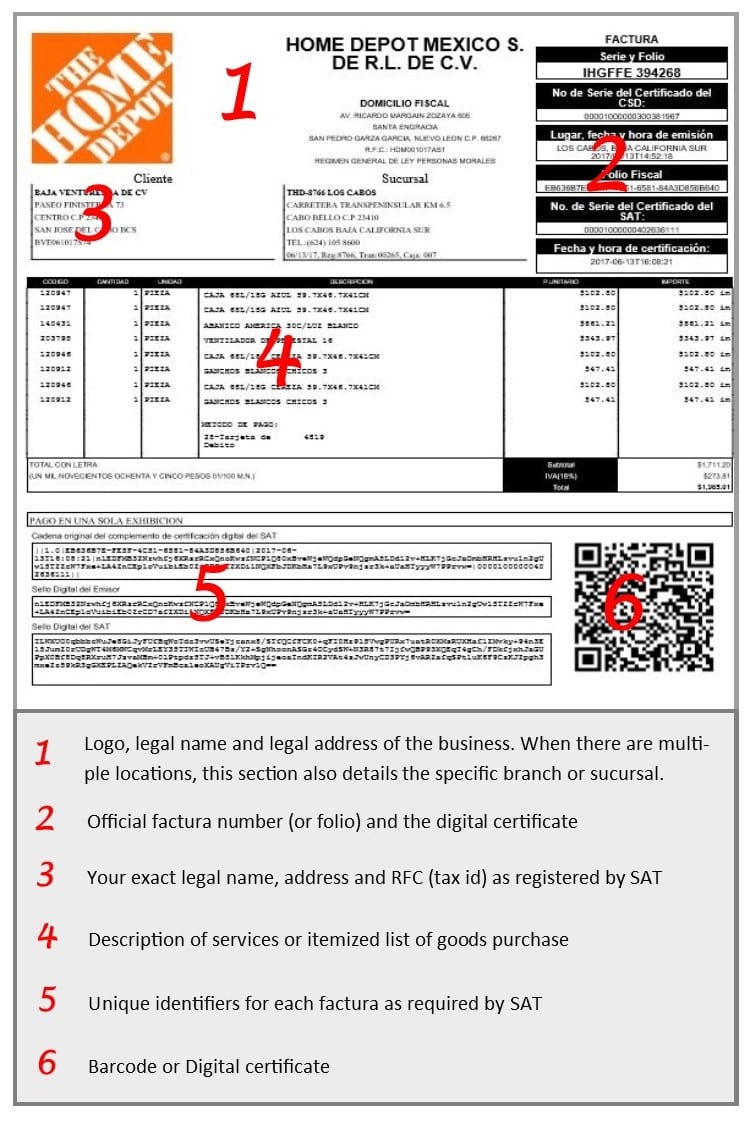What is a Factura?
by Baja Real Estate Guide

In simple terms, a factura is a receipt. If you’ve bought a good or paid for a service that needs to be tax deductible in Mexico, you must have a factura. Even if you don’t own a business in Mexico, you may be asked for a factura for example on an insurance claim or for capital gains deductions. So the next time someone asks you, “requiere factura?” read on so you can comfortably answer yes or no!
ASK FIRST
If the factura is important to you, ask before you make the purchase if they will give you one. Businesses are required by law to generate facturas on every purchase, but in practice there tends to be more of a gray area. Some businesses will forgo charging you the 16% iva sales tax if they don’t have to create a factura. By not generating the factura, a business doesn’t have to report the income.
WHAT YOU WILL NEED TO PROVIDE
In order to create your factura, a business will need your legal name, your legal address and your RFC (tax ID) as registered with SAT (the Mexican equivalent of the IRS or CRA). When you receive the factura, check each of these details to make sure there aren’t any mistakes. The smallest mistake can be a reason for Hacienda to one day reject your tax deduction.
If you don’t have an RFC, you can still ask for a factura by using a universal RFC tax ID called Publico en General with an RFC of XAXX010101000.
FACTURAS ARE ELECTRONIC
ALL facturas are now electronic. They are generated through government approved third parties and are not something you can create in your home office. A business will typically pay for a fixed amount of facturas for a calendar year depending on their projected number of transactions, and then they’ll log onto the third party’s website to create the actual factura by plugging in the client’s fiscal information along with the goods/services that were purchased. Once the factura is saved, it is synced immediately with SAT (IRS or CRA) and reported as income. Facturas are generated real time, so there is no way to post-date or back date them. They can be cancelled if necessary.
TWO PARTS TO A FACTURA
There are two parts to the factura:
- an XML file that is the real electronic receipt that SAT (IRS or CRA) uses. It looks a little bit like website code!
- a PDF file with all of the same information in the XML file but in a fairly reader friendly format (see example below)
Most businesses will offer you only a paper print out of the PDF. The paper print out contains all the necessary information for an accountant to download the official XML electronic file, but to protect yourself, it’s good practice to request the factura also be emailed to you. In that email, you should receive both the PDF and the XML file. If you receive only the PDF file, your accountant can download the XML from SAT’s system, but the government, for whatever reason, could possibly delete that XML file from its database. Thus, it’s good practice to make sure you have a copy of the XML file in your records.
LIMITED TIME TO REQUEST ONE
Taxes are filed monthly in Mexico, so you’ll want to make sure to request your factura in the same month of the purchase of the good or service. Most companies will have a policy against generating facturas after the month has closed. Larger companies are even stricter with a small window sometimes of only 15 days or less to go back and request a factura, if you didn’t ask for it at the time of purchase.
BUSINESS BUY FACTURAS
Facturas actually cost money. Small to large businesses will have an annual plan with a third party factura provider, but independent service folks may have to buy each factura separately. Not only does the purchase of the factura cost money, but by using facturas, they then also have to hire an accountant who can file the appropriate associated taxes. Thus, you may find some of the independent people requiring a minimum purchase for them to offer you a factura. Again, if the factura is important to you, make sure you have that conversation with the service provider prior to hiring him/her!
A FEW TIPS
Just having a factura doesn’t in itself guarantee the tax deduction. A few key rules to know are:
- If a factura is for more than $2000 pesos, it will not be tax deductible if the payment is made in cash. For purchases over $2000 pesos, the purchase must be made either by check, bank transfer or credit card.
- If you are paying with a check, bank transfer or credit card, it must be from an account that matches up with the legal name/address/tax ID you’ve given for the factura. For example, if you’ve given your personal name/address/tax ID for the factura, then the money needs to be sent from an account with your name on it.
- Likewise, whomever you’re sending money to via check, bank transfer or credit card, the account where you are sending it must coincide with the exact company name that is on the factura you receive.
BRINGING IT HOME
You’ve purchased a home in Mexico that you plan to remodel. You want to make sure the investment you’re about to make in your new home will be applied toward any capital gains taxes if and when you go to sell the property. The 1st step in that process, is making sure you have facturas for the work that is done. You’ll need to pay a contractor or architect on a regular basis. Avoid the urge to hand over cash or wire transfer money to your property manager! You will want to wire transfer money or pay with a Mexican check, making sure that the name on the account you send the money FROM and the name on the account you send the money TO are both on the factura you receive.
If you don’t have an RFC, make sure you request all facturas then be made out to Publico en General with an RFC of XAXX010101000.
WRAPPING IT UP
If you think about it from a government’s perspective, facturas won’t seem as complicated. They are simply the government’s efforts at making sure 1) taxes are being paid, and 2) the money is coming from a legitimate source (in other words ‘clean money’).
THE DIFFERENT PARTS OF A FACTURA




